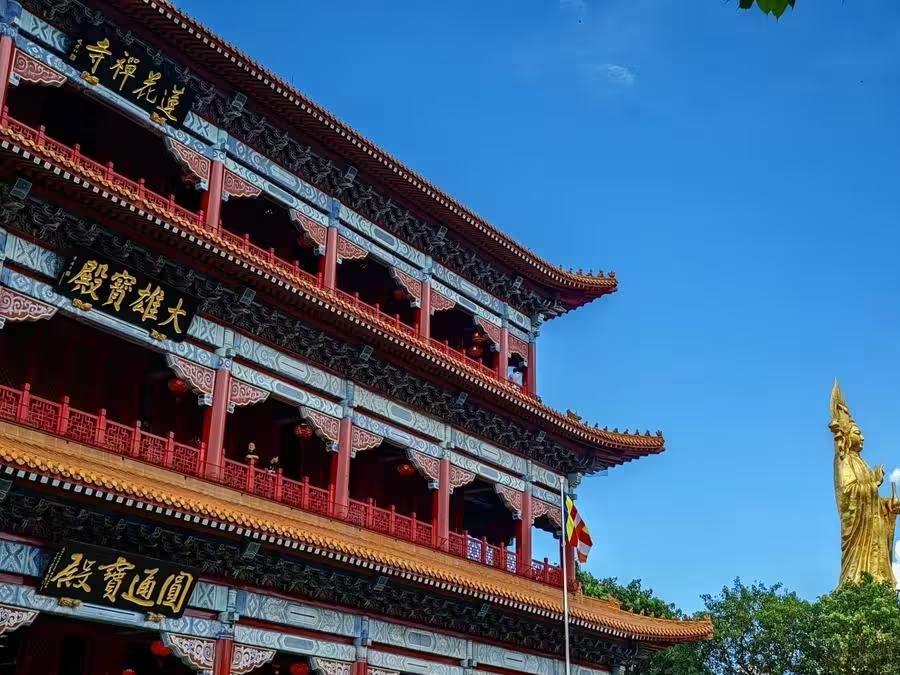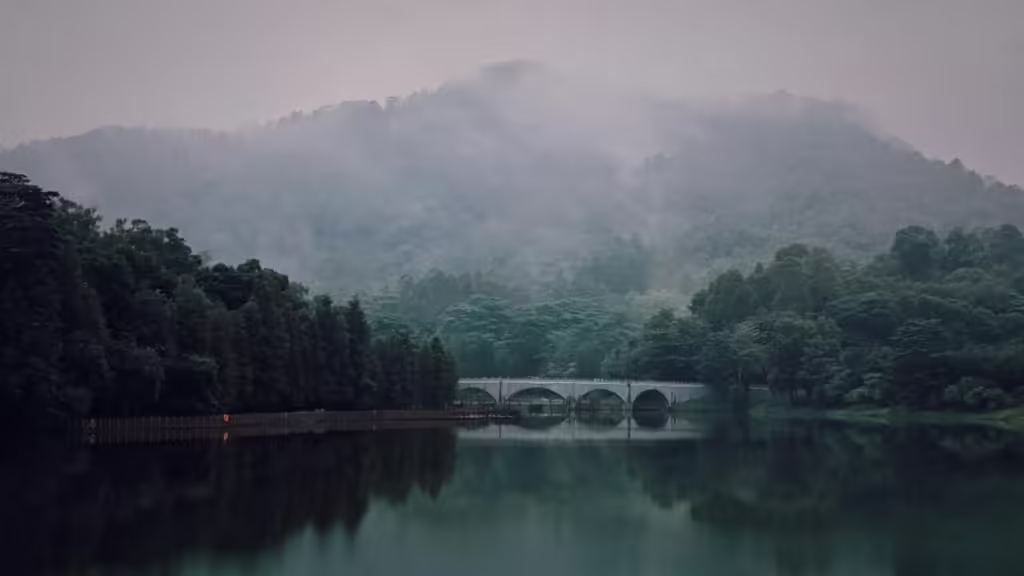Lotus Mountain (莲花山, Lianhua Mountain), located in the eastern part of Panyu District in Guangzhou, was originally named “Stone Lion’s Head (石狮头).” It is composed of 48 low hills made of red sandstone and derives its name from a rock at its peak that resembles a lotus flower. This picturesque mountain is one of the scenic spots in the new century’s “Eight Views of Yangcheng,” making it an excellent choice for exploring ancient sites, enjoying flowers, and relaxing.
Historically, Lotus Mountain served as a stone quarry, with its stones primarily used in the construction of government buildings, markets, ancestral halls, temples, and tombs, earning it the title “Source of City Construction.” Over the course of more than 2,000 years, from the Western Han Dynasty to the Qing Dynasty, generations of southern Guangdong ancestors tirelessly carved and shaped the landscape, resulting in a remarkable collection of stone formations that stretch for several kilometers. Notable attractions include Swallow Rock, Lotus Stone, Lion Rock, White Elephant Rock, Eight Immortals Rock, and Eagle Cliff.
Table of Contents
- Basic Information
- Location and Transportation
- Highlights of Lotus Mountain
- Vlog about the Lotus Mountain
- Other Attractions in Guangzhou Panyu District
Basic Information
| Estimated Length of Tour | 2 hours |
| Ticket Price | 54 RMB |
| Opening Hours | 7.00 – 17.00 |
| Telephone Number | 0086-020-84865282 0086-020-84861599 |
Location and Transportation
Lotus Mountain is located at 123 Ximen Road, Panyu District, Guangzhou, Guangdong Province, China. Visitors can reach the mountain by taking bus routes 128, 162B, or 92 to the Lotus Mountain Station, from which it is a short walk to the scenic area.
Highlights of Lotus Mountain
Lotus City

Established in the third year of the Kangxi era (1664) during the Qing Dynasty, Lotus City is located at the northeastern corner of Lotus Mountain and covers an area of over 10,000 square meters. The irregular oval-shaped fortress features walls that rise over 10 meters high, equipped with crenellations and walkways for lookout and patrol purposes. Offering a commanding view of the Shiziyang Sea, Lotus City occupies a strategic position that oversees Humen and the surrounding areas, hence its nickname “Defender of the Mountain Fortress.” Originally, the fortress was garrisoned by troops until its gradual decline in the late Qing Dynasty. In the early 1980s, with the support of the National Cultural Heritage Administration, Lotus City was restored based on the remains of its collapsed walls. Inside, visitors can find exhibitions showcasing the original layout of Lotus City, displays of the Qing Dynasty’s Eight Banners military system, as well as a discussion hall, general’s tent, couples’ tent, and entertainment tent, offering detailed insights into the history of the Eight Banners army.
Avalokitesvara of the Sea

The Avalokitesvara statue, known as “Wang Hai Guanyin,” was initiated by Mr. He Houhua and supported by the He Xian Social Welfare Foundation and various devotees. Completed in 1994, this impressive statue stands 40.88 meters tall, made of 120 tons of bronze, and is adorned with 180 taels of pure gold leaf. In front of the statue are two mythical Qilin beasts, engraved with the phrases “National Prosperity and Peace” and “Favorable Weather for Harvest.”
Lotus Zen Temple

Originally named Guanyin Pavilion, Lotus Zen Temple is dedicated to the worship of Avalokitesvara Bodhisattva, showcasing a majestic and classical architectural style. The temple houses various Avalokitesvara statues of differing materials and expressions, with resident monks present. The main hall on the first floor features the Thousand-Hand and Thousand-Eye Avalokitesvara, symbolizing the ability to protect all beings and observe the world. On the third floor, the main hall houses a statue of the White Jade Avalokitesvara, who wears a heavenly crown with an Amitabha Buddha seated above her.
Lotus Tower

Originally named “Wenchang Tower” and also known as “Lion Tower,” Lotus Tower was constructed in the 40th year of the Wanli era (1612) during the Ming Dynasty. It was funded by local scholars Li Weifeng, Liu Ruxing, and Chen Kui, among others. Standing at 50 meters tall, the tower has an exterior of nine levels and an interior of eleven levels. At the top, it features a statue of Confucius, revered as the “Teacher of All Ages.” The tower is octagonal in shape, symbolizing the eight trigrams of heaven, earth, yin, yang, wind, thunder, water, and fire. Each corner of the tower’s eaves is adorned with a wind chime, totaling seventy-two, making it a classic example of traditional Chinese architecture.
Festivals at Lotus Mountain

Lotus Festival: From June to August each year, the Lotus Mountain Scenic Area hosts a grand Lotus Festival. Set against the picturesque backdrop of the lotus paradise, the festival features breathtaking performances of song and dance, along with unexpected displays of talent, entertaining visitors.
Peach Blossom Festival: Occurring around the Spring Festival, the Peach Blossom Festival celebrates the blooming of thousands of peach trees in a 40-acre garden adjacent to the Lotus Tower. This vibrant display of blossoms attracts many visitors eager to witness the beauty of spring.
Double Ninth Festival: A traditional highlight of the Double Ninth Festival at Lotus Mountain is the elaborate lighting displays. The main attractions in the scenic area are decorated with LED lights, sesame lanterns, fireworks lanterns, and windmill lanterns. The festival also includes a special evening banquet, local delicacies, and a variety of lively song and dance performances.








